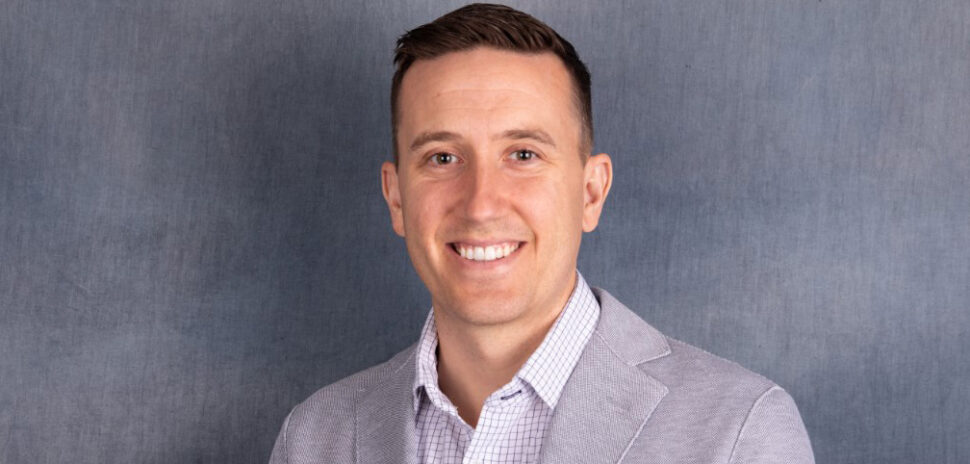Flash back to your high school chemistry class, and you’ll perhaps recall that all matter is made up of atoms; all elements are organized—by atomic number and electron configuration—into the periodic table; and a catalyst is a substance that is used to spur on and speed up a chemical reaction.
Likewise in commercial real estate, a catalyst site can be considered one that is ready to boom. With public and private improvements already in place (the atoms, if you will), these locations duel and dance with one another to find financing, dazzle developers and brokers, and, ultimately, attract tenants. Dallas-Fort Worth is home to a number of these catalyst sites, which could potentially change the trajectory of the entire region.
The nucleus
Rewind back to the end of last year when Amazon was on the hunt for its HQ2 site. Local developers were able to amass more than 28 million square feet of potential urban office space in its bid—more than three-times what Amazon had asked for in its request for proposal.
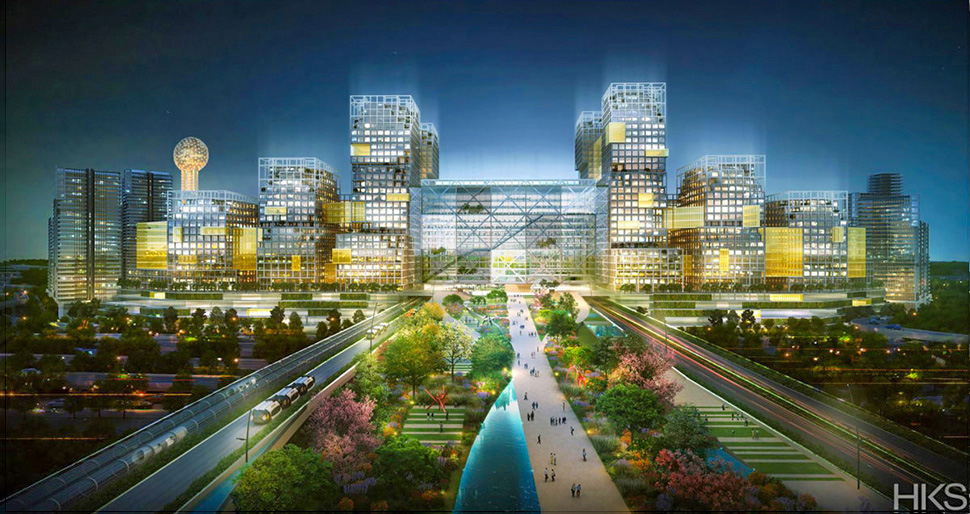
Dallas’ proposed “Super Site” for Amazon’s HQ2 included plans for a massive new deck park over Interstate 30, as well as additional office and residential buildings. [Rendering: HKS]
According to Dallas-based architecture firm HKS, which compiled some of the urban bids located in downtown Dallas, the so-called “Super Site” included plans for a massive new deck park over Interstate 30, the gateway to Dallas overlooking the Trinity River, and a host of other office and residential buildings. Though Amazon ultimately chose HQ2 sites elsewhere, the parcels and projects assembled for Dallas’ bid remain actively in play, just waiting for its next big relocation tenant.
CEO Mike Hoque of Dallas-based Hoque Global was one of those bids. His 20-acre site in downtown, nicknamed the Dallas Smart District, got a lot of press as a contender for Amazon HQ2. More recently, though, Hoque obtained zoning approvals for his site in the Cedars, which includes a derelict Pilgrim’s Pride plant. He named the project SoGood @ Cedars, in a nod to South Dallas and Good-Latimer, where the property exists. Designed by Hoque Global and Plano-based multifamily architecture firm Domus Studio Group, initial plans include 260 units and 50,000 square feet of retail, which will add much-needed apartments and residents to the already bustling daytime crowd and be a driver for contined growth in downtown Dallas.
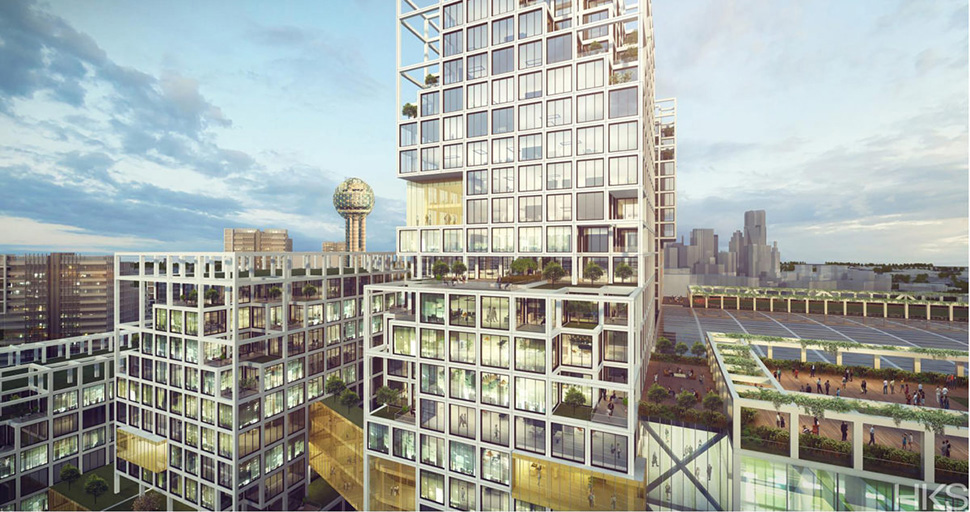
This proposed Reunion site facade was part of the 28 million square feet amassed for Dallas’ Amazon HQ2 pitch. [Rendering: HKS]
Hoque says assembling the many individual tracts and parcels for development was no small feat. “For four years, I spent every waking hour on this mission,” he says. “I was like a mad man, going after all of these little pieces of property, one at a time. It was all-consuming.”
Another potentially game-changing announcement for downtown Dallas is the May 2019 announcement that Charlotte, North Carolina-based real estate investment firm Asana Partners would acquire 421,617 square feet collection of retail and office properties in the heart of Victory Park.
Within walking distance of American Airlines arena and at the intersection of downtown and Uptown, Victory Park is home to more than 3,500 apartments and an additional 1.5 million square feet of existing office space, not including the newly announced projects like Hines’ 39-story luxury tower The Victor and Kaizen Development Partners’ 300,000 square-foot office project The Link.
Both projects, combined with the infusion of investment capital in Victory Park, make the neighborhood an attractive one for continued development in the coming years as fresh capital is infused into the walkable neighborhood at the center of it all.
Another neighborhood in downtown Dallas that is prime for continued expansion is Deep Ellum. In addition to Uber’s exciting announcement to bring 3,000 jobs to the area and office from the 26-story building, The Epic, developed by KDC, Asana Partners made its first foray into Dallas real estate with its acquisition of some 30 buildings and parking lots from Dallas-based 42 Real Estate in the summer of 2017.
“Asana has a lot of really good ideas for Deep Ellum—to put in sidewalks, better lighting, parking lots, landscaping—all of the things I’ve been wanting to do but needed someone to come alongside to do it,” 42 Real Estate Owner Scott Rohrman said at the time. The bustling Deep Ellum is on the upswing with its flurry of restaurants, retail, and night life that make it a popular hangout for many millennials and Gen Zers.
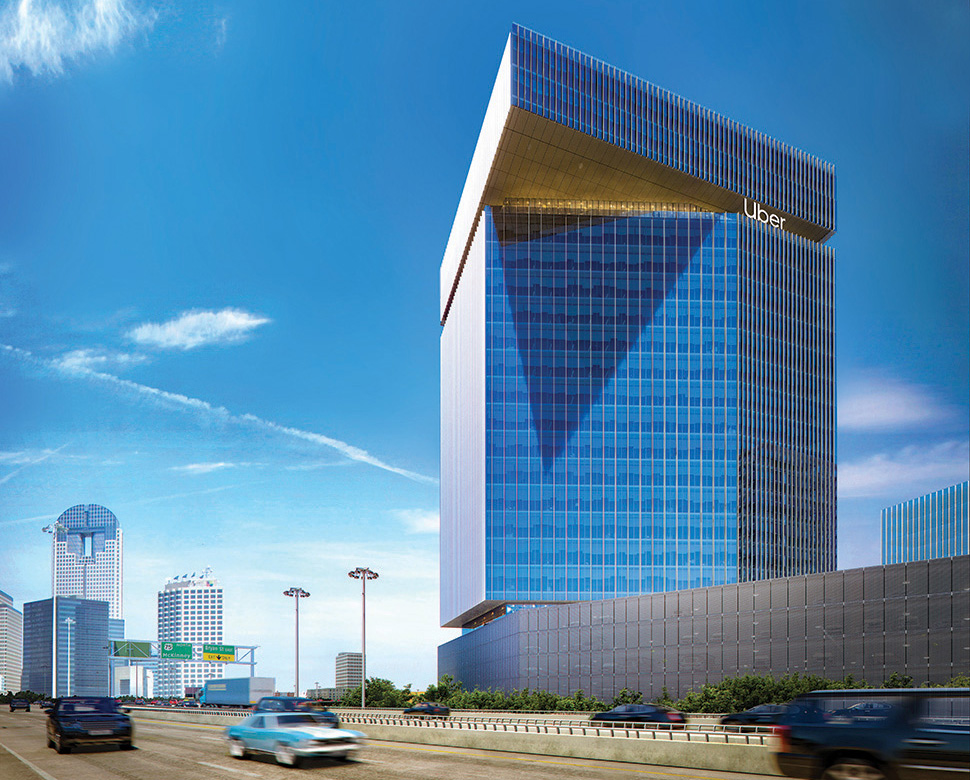
Uber made one of the biggest North Texas real estate announcements in recent years—that it would be taking 450,000 square feet of space in a planned tower at The Epic mixed-use development on the eastern edge of downtown Dallas in Deep Ellum. Uber is bringing 3,000 jobs to The Epic with a move in that will be in two parts and take a couple of years to complete. [Rendering: Westdale Real Estate Investment & Management]
Finally, after three years of starts and stalls on the project, the 52-story, 1.5 million-square-foot First National Bank Tower will get its redevelopment by Dallas-based Todd Interests. The project marks a milestone for downtown Dallas, too. By the end of 2020 when the project is set to complete, downtown Dallas will have gone from 42 vacant buildings in 1990 to zero. It all adds up to a robust urban core with more than 135,000 daytime employees, an average Walk Score of 97, and a submarket that was No. 1 in net office leasing in 2018, according to Downtown Dallas Inc. statistics.
“Fast forward through two decades of redevelopment—catalyzed by public-private partnerships, the introduction of urban dwellers, the return of business, and evolution of a livable downtown with parks, restaurants, arts, and amenities—and our last albatross has turned,” says Downtown Dallas Inc. president Kourtny Garrett. “The redevelopment of our last major vacant building in downtown Dallas is most certainly a milestone to celebrate, but it’s not the end of the story. It will serve as a catalyst for more bold, new projects that will turn the market’s focus to complementary infill development throughout several major opportunity sites.”
Headquarters of headquarters
Any conversation about developments that are spurring activity in DFW must include visionary Fehmi Karahan’s 250-acre Legacy West. The iconic mixed-use development along the 121 Highway corridor is one of the most successful in the country, attracting corporate headquarters and regional hubs such as Toyota Motor North America, Liberty Mutual, JP Morgan, Boeing, J.C. Penney, and Pizza Hut—to namedrop just a few of the larger corporate tenants residing in the Plano development.
The estimated $2 billion Legacy West mixed-use project has spurred The Shops at Legacy and three-story Legacy Hall Food Hall, in addition to much-needed multifamily housing for Plano and in-fill projects for the city.

The Legacy West development led to numerous other projects in Plano. [Rendering: Legacy West]
Karahan, who was deservedly inducted into the North Texas Commercial Association of Realtors and Real Estate Professionals Hall of Fame this year for his work at Legacy West, is unsurprisingly playing an integral role in the development of Frisco’s mixed-use development anchored by the PGA of America’s new headquarters and the 2,500-acre Hunt Realty master planned Fields in Frisco—another catalyst site in the region for the influx of more than $2.5 billion over the next 20 years based on a city commissioned tourism feasibility survey.
The PGA of America will invest $30 million to build its new 100,000-square-foot global headquarters and education facility and has pledged to bring major golf competitions to the region in the not-so-distant future—earning Frisco the new “Sports City, USA” designation with the advent of The Star, an unprecedented 600,000 square feet of mixed-use space and home of the Dallas Cowboys.
“Not only will this signature development change the future of Frisco’s northern landscape, it will transform the sport, growing a new generation of pros, fans, and golf enthusiasts,” says Frisco Mayor Jeff Chaney on the estimated $530 million public-private project.
Certainly in the same catalyst site conversation is Irving’s corporate headquarter stronghold in the region. Thirteen Fortune 1000 companies call Irving home—about one-third of all those located in DFW, according to JLL research. Most notably, McKesson, the nation’s sixth-largest company, moved its headquarters from San Francisco to Las Colinas and brought with it 1,000 jobs to the region beginning in November 2018.
A catalyst development in Irving to keep an eye on as it continues buildout is Hidden Ridge, a $1 billion, 5G-enabled mixed-use campus being developed between John Carpenter Freeway and MacArthur Boulevard by Verizon and Dallas-based KDC. The 150-acre site will also house the new 1.2-million-square-foot headquarters for Pioneer, which is slated for move in later this fall.
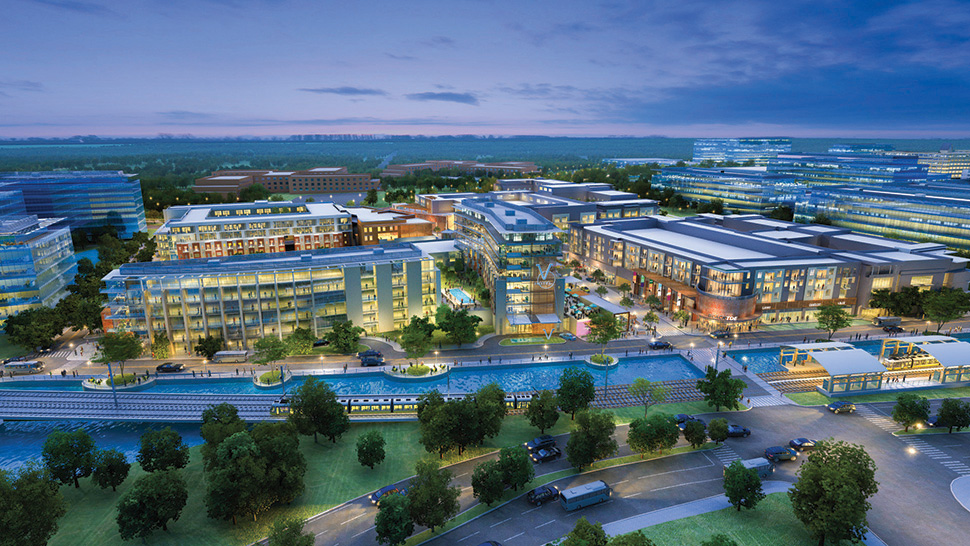
Hidden Ridge will be a 5G-enabled mixed-use campus in Irving. [Photo: Gensler]
Finally, in Allen is where you’ll find the master-planned Monarch City, a 270-acre development with plans for 9 million square feet of Class-A office, retail, and residential space, plus a luxury hotel. The Howard Hughes Corp. is the developer (and you can read more about its catalytic development beginning on Page 50).
Westworld
On the western edge of Dallas-Fort Worth, as AllianceTexas turns 30 years old this year, it continues to be a catalyst for development and innovation.
In fact, its 26,000 acres of master-planned space will be leading North Texas and the nation forward with the development of futuristic ground and air transportation technologies, developer Hillwood announced this year.
Hillwood wants to turn the vast spread into an “AllianceTexas Mobility Innovation Zone” to develop and deploy new transportation technologies, from autonomous cars and trucks to high-flying drones. Hillwood says it intends to leverage the development’s national prominence and name to create a cutting-edge center of innovation and a global catalyst for the future of mobility.
“Dallas-Fort Worth is regarded as one of the world’s premier transportation hubs, and for the last 30 years AllianceTexas has played a significant role in the region’s growth and success,” Hillwood Chairman Ross Perot Jr. says.
“With more than 500 corporations in residence at AllianceTexas, including many of the world’s leading transportation and logistics companies, the development continues to be an epicenter of growth and ingenuity that will provide top innovators with everything they need to succeed, from transportation infrastructure to world-class amenities, and access to a highly skilled workforce.”
The development has more than 160 miles of major roads and federal and state highways, which gives it plenty of space to test autonomous cars and trucks. Its vast sky will accommodate the latest technology in autonomous aviation. The development is an inland port and is home to Fort Worth Alliance Airport, BNSF Railway’s Alliance Intermodal Facility, FedEx Southwest Regional Sort Hub, Amazon Air’s new regional air hub, and more than 500 global and regional brands.
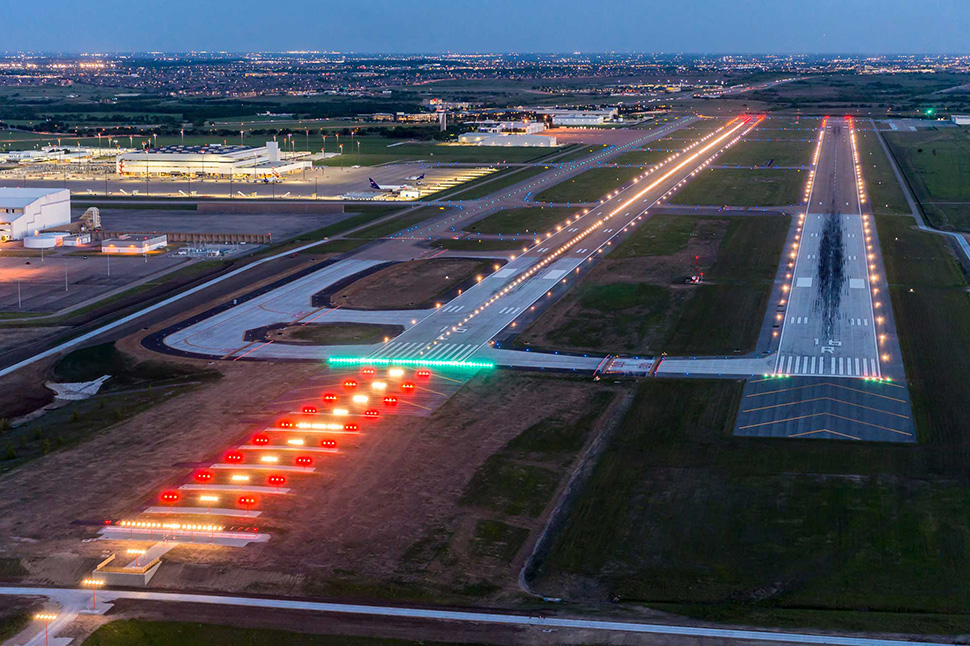
[Photo: Hillwood]
Shopping and entertainment meccas
Just as corporate headquarter relocations and expansions infuse jobs into the region to catalyze development, so, too, does the expansion of shopping and entertainment venues across the region.
Look no further than Arlington’s shiny, new $250 million Texas Live! dining, entertainment, and hospitality district, which was completed last year by Major League Baseball’s Texas Rangers, the city of Arlington, and Baltimore, Maryland-based developer The Cordish Companies.
The development is the perfect game-day attraction for Globe Life Park, which will become home to DFW’s new XFL team the Dallas Renegades next year; the under-construction $1.1 billion Globe Life Field, which will be completed by spring 2020; and the Dallas Cowboys’ AT&T Stadium. Professional sports are often catalytic in attracting mass spectators for one-time events. However, with Texas Live! and additional retail and restaurant options around the stadiums, Arlington will continue to benefit from its central location in the region to draw from population bases in both Dallas and Fort Worth.
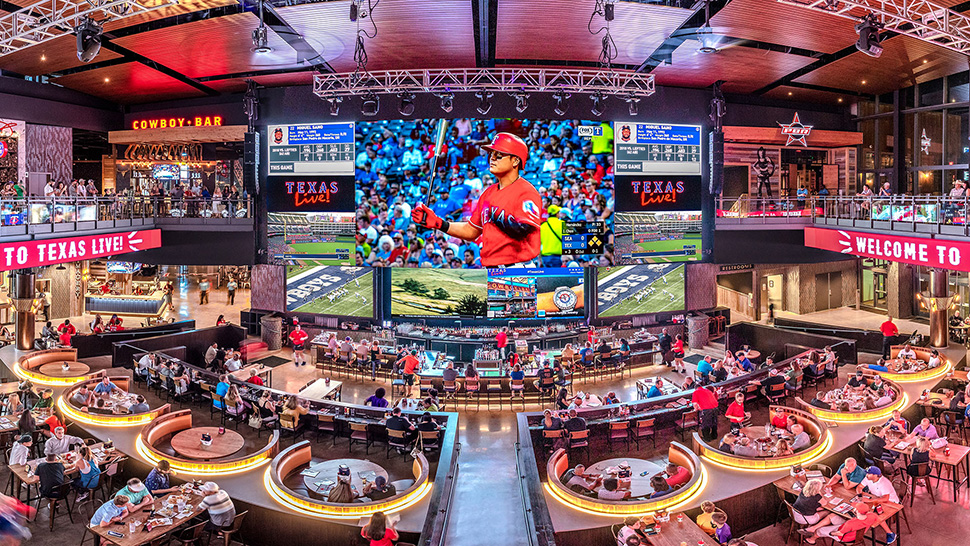
Texas Live! is Arlington’s newest dining, entertainment, and hospitality district. [Photo: Cordish Companies]
DFW’s newest concert venue is also a game-changer for the region. The 8,000-capacity Toyota Music Factory, which opened last year, was projected to do 60 shows in 2018. Instead, it hosted 100 performances. According to Noah Lazes, president of The Ark Group, which developed and manages the facility, Toyota Music Factory drew 3 million people to Irving to various shows last year, boosting the retail and restaurants in the 500,000-square-foot complex. Popular Austin-based movie theater company Alamo Drafthouse debuted a new North Texas location at Toyota Music Factory—and with it the development continues to add amenities for both daytime workers and residents in Las Colinas.
Not to be outdone, The Billngsley Cos.’ The Sound in Far North Dallas debuted its amphitheater venue mostly as a one-acre, park and retail amenity at the center of the larger 1,000-acre Cypress Waters project. Today, the mixed-use development boasts more than 14,000 workers for companies including CoreLogic, 7-Eleven, Nationstar Mortgage, and Nokia. Its newest 250,000-square-foot building is expected to be completed later this year and is located across the street from the new lakefront amphitheater.
Destination shopping at Warren Buffett-backed Grandscape in The Colony has seen that project balloon to $1.5 billion and 433 acres along the Sam Rayburn Tollway with marquee tenant Nebraska Furniture Mart. With IKEA opening less than a mile way in 2015, it has paved the way for more entertainment options, like Top Golf, which opened its successful 121 location in April 2014, and, more recently, Hawaiian Falls water park in 2018 near corporate tenants at Legacy—and beyond.
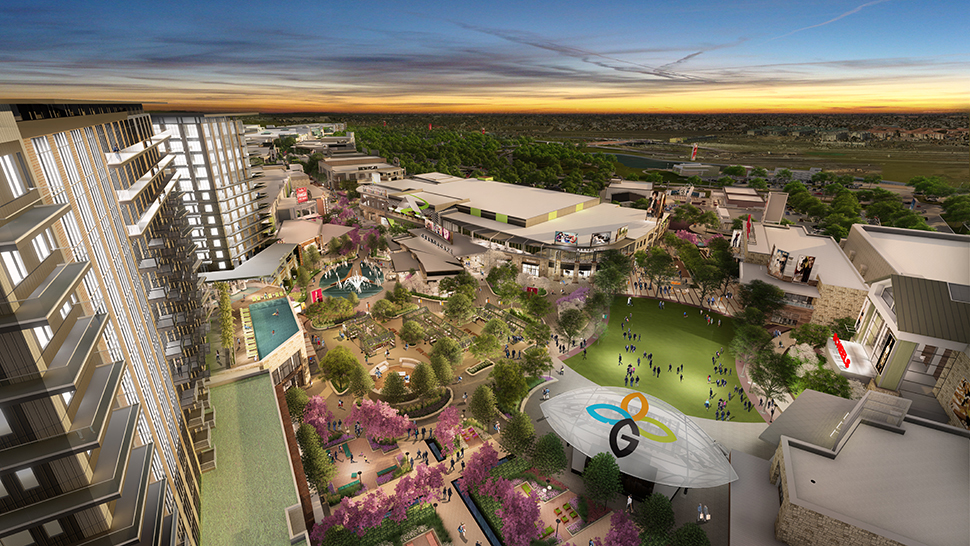
The Warren Buffett-backed $1.5 billion Grandscape in The Colony has attracted 8 million shoppers a year. Its 433 acres has more than a mile of frontage on Sam Rayburn Tollway. Announced dining, residential, and entertainment locations will join marquee tenant Nebraska Furniture Mart into 2021. [Rendering: Grandscape]
Finally, aging malls are finding new life in projects in Midtown near the Galleria, Collin Creek in Plano, and Redbird in South Dallas, with large-scale planned mixed-use communities by Beck Ventures, Centurion American Development Group, and private investors. All three projects will be pivotal in energizing the communities they’re in. And energy, after all, is something found all around the region.
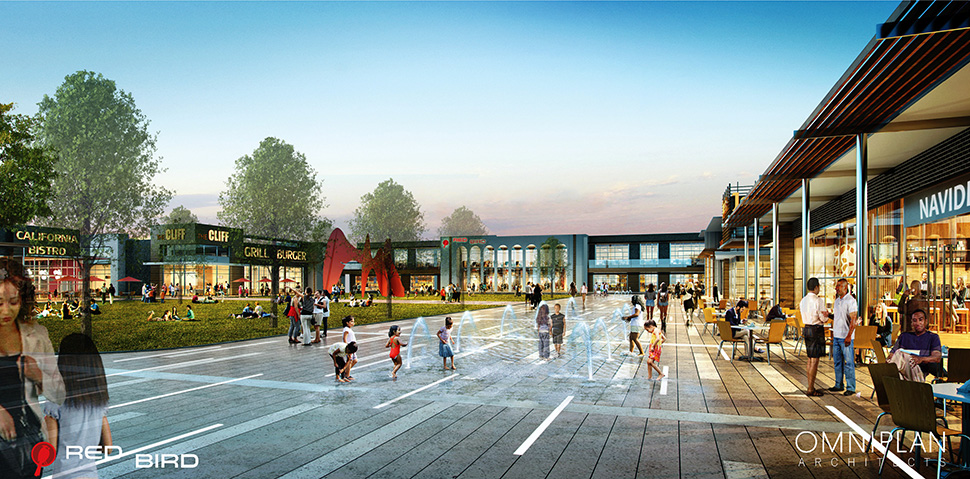
Redbird mall is being revitalized in South Dallas. [Rendering Omniplan]
This article was originally published in the Summer 2019 edition of the Dallas-Fort Worth Real Estate Review.
![]()
Get on the list.
Dallas Innovates, every day.
Sign up to keep your eye on what’s new and next in Dallas-Fort Worth, every day.





![Dr. Justin Lonon, vice chancellor of Dallas College, addresses the crowd at the recent Goldman Sachs 10,000 Small Businesses Dallas Graduation. [Photo: 10KSB]](https://s24806.pcdn.co/wp-content/uploads/2021/06/GoldmanSachs-10KSB-4992-970-970x464.jpg)
